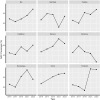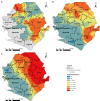Re-assessment of schistosomiasis in nine endemic districts with cluster sampling in Sierra Leone
- PMID: 38932788
- PMCID: PMC11199885
- DOI: 10.3389/fpubh.2024.1415486
Re-assessment of schistosomiasis in nine endemic districts with cluster sampling in Sierra Leone
Abstract
Background: Baseline mapping showed that schistosomiasis was highly/moderately endemic in nine districts in Sierra Leone. Mass drug administration (MDA) with praziquantel started in 2009, and after multiple rounds of treatment, an impact assessment was conducted in 2016 followed by a second re-assessment in 2022 using cluster sampling to provide more granular data for refining chiefdom (sub-district) treatment strategies.
Methods: On average, 20 rural villages were systematically selected per district by probability proportional to population size across the nine districts. Surveys were conducted in schools, and 24 school children aged between 5 and 14 years were randomly selected, with an equal number of boys and girls. One stool sample and one urine sample were collected per child. Two Kato-Katz slides were examined per stool for Schistosoma mansoni infection. Hemastix strips were used as a proxy for S. haematobium infection with urine filtration used for egg counts on hematuria-positive samples.
Results: In total, 4,736 stool samples and 4,618 urine samples were examined across 200 schools in 125 chiefdoms. Overall, the prevalence of S. mansoni was 16.3% (95% CI: 15.3-17.4%), while the overall prevalence of S. haematobium was 2.0% (95% CI: 1.6-2.4%) by hematuria. The prevalence of heavy infections for S. mansoni and S. haematobium was 1.5% (95% CI: 1.1-1.9%) and 0.02% (95% CI: 0.0-0.14%), respectively. Among 125 chiefdoms surveyed, the overall schistosomiasis prevalence was <10% in 65 chiefdoms, 10-49.9% in 47 chiefdoms, and ≥ 50% in 13 chiefdoms. There was a mixed relationship between schistosomiasis in school children and WASH access in schools.
Conclusion: Sierra Leone has made significant progress in reducing schistosomiasis prevalence across the country after a decade of MDA intervention. However, high prevalence remains in some hotspot chiefdoms. The next steps are for the national program to investigate and address any potential issues such as low coverage or poor knowledge of schistosomiasis risk behaviors and, where appropriate, consider broadening to community-wide treatment in hotspot chiefdoms or communities.
Keywords: Schistosoma haematobium; Schistosoma mansoni; Sierra Leone; cluster sampling; impact assessment; schistosomiasis.
Copyright © 2024 Kargbo-Labour, Redwood-Sawyerr, Conteh, Chop, Bah, Koroma, Kabia, Klein, Juneja, Houck, Reid, Evans, Weaver, Phillips and Zhang.
Conflict of interest statement
The authors declare that the research was conducted in the absence of any commercial or financial relationships that could be construed as a potential conflict of interest.
Figures




Similar articles
-
High level of Schistosoma mansoni infection in pre-school children in Sierra Leone highlights the need in targeting this age group for praziquantel treatment.Acta Trop. 2012 Nov;124(2):120-5. doi: 10.1016/j.actatropica.2012.07.005. Epub 2012 Jul 20. Acta Trop. 2012. PMID: 22820025
-
Mass drug administration significantly reduces infection of Schistosoma mansoni and hookworm in school children in the national control program in Sierra Leone.BMC Infect Dis. 2012 Jan 22;12:16. doi: 10.1186/1471-2334-12-16. BMC Infect Dis. 2012. PMID: 22264258 Free PMC article.
-
Praziquantel treatment of school children from single and mixed infection foci of intestinal and urogenital schistosomiasis along the Senegal River Basin: monitoring treatment success and re-infection patterns.Acta Trop. 2013 Nov;128(2):292-302. doi: 10.1016/j.actatropica.2012.09.010. Epub 2012 Sep 26. Acta Trop. 2013. PMID: 23022016
-
Differential impact of mass and targeted praziquantel delivery on schistosomiasis control in school-aged children: A systematic review and meta-analysis.PLoS Negl Trop Dis. 2019 Oct 11;13(10):e0007808. doi: 10.1371/journal.pntd.0007808. eCollection 2019 Oct. PLoS Negl Trop Dis. 2019. PMID: 31603895 Free PMC article.
-
A meta-analysis of changes in schistosomiasis prevalence in Zambia: implications on the 2020 elimination target.Parasitol Res. 2020 Jan;119(1):1-10. doi: 10.1007/s00436-019-06534-0. Epub 2019 Nov 26. Parasitol Res. 2020. PMID: 31773307 Review.
Cited by
-
Prevalence of schistosomiasis and its association with anemia in Ethiopia, 2024: a systematic review and meta‑analysis.BMC Infect Dis. 2024 Sep 27;24(1):1040. doi: 10.1186/s12879-024-09926-5. BMC Infect Dis. 2024. PMID: 39333889 Free PMC article.
References
-
- WHO . Ending the neglect to attain the sustainable development goals: A road map for neglected tropical diseases 2021–2030. Geneva: World Health Organization; (2020).
-
- WHO . Schistosomiasis and soil-transmitted helminthiases: progress report, 2021. Wkly Epidemiol Rec. (2021) 97:621–32.
-
- WHO . Preventive chemotherapy in human helminthiasis: Coordinated use of anthelminthicdrugs in control interventions: A manual for health professionals and programmemanagers. Geneva: World Health Organization; (2006).
-
- WHO . WHO guideline on control and elimination of human schistosomiasis. Geneva: World Health Organization; (2022). - PubMed
MeSH terms
Substances
LinkOut - more resources
Full Text Sources
Medical

